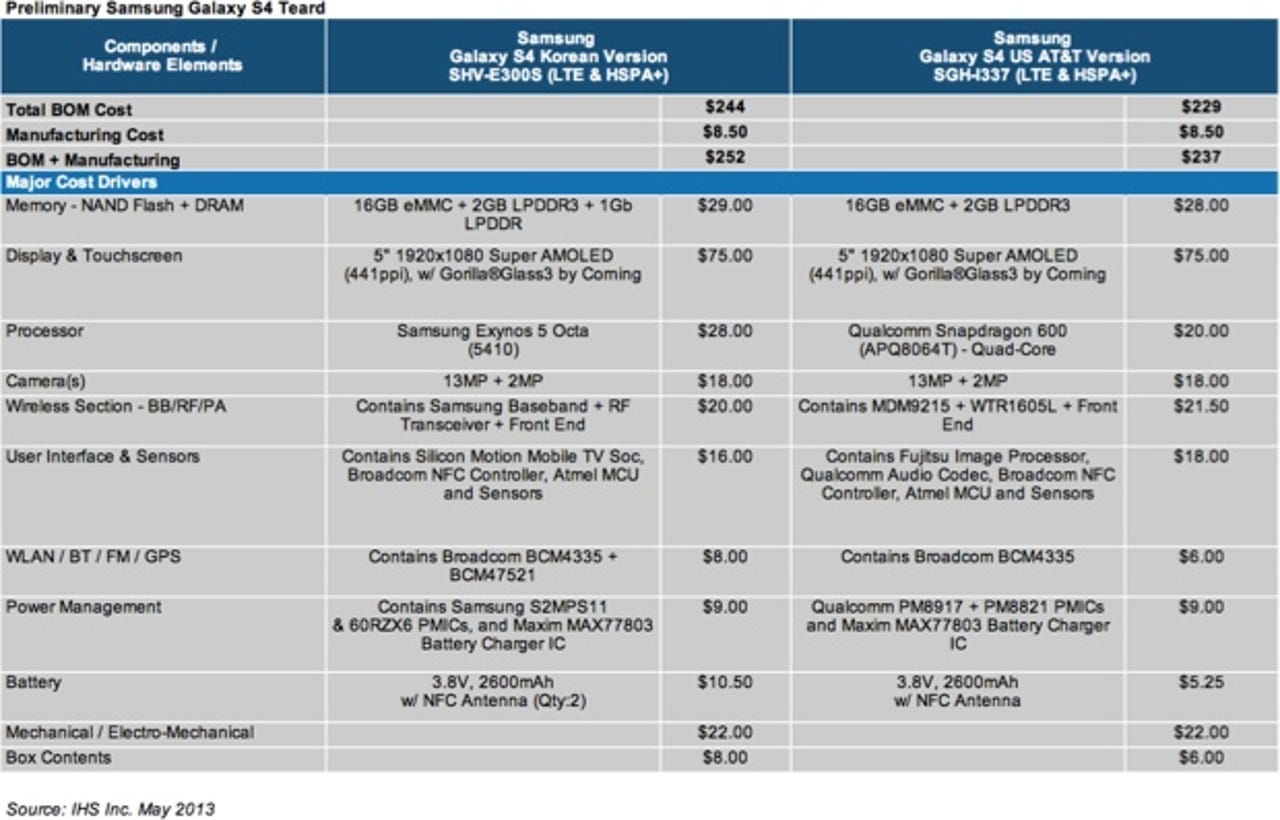Korean and US versions of Samsung Galaxy S4 'as different as kimchee and coleslaw': IHS

From the outside, the American and Korean versions of Samsung's new Galaxy S IV might seem identical, but peel back the case, and you'll find that they are as different as, in the words of research firm IHS, kimchee and coleslaw.
And we're not talking small differences, either; we're talking major differences that change the fabric of the entire handset, including the processor, the wireless subsystem, and even the user interface.
The differences between the two smartphones mean that they have a very different bill of materials (BOM).
The US Galaxy S4 with 16GB of NAND flash storage has a BOM of $229, rising to $237 when the manufacturing cost is added. The Korean version of the smartphone, with the exact same memory configuration, has a BOM of $244, which rises to $252 when manufacturing is added.

"With at least four different known incarnations of the Galaxy S4, Samsung is demonstrating its strategy of offering a mobile product that has appealing features and pricing — and then adapting the device to suit the tastes of varying markets or regions," said Vincent Leung, senior analyst, teardown services, for IHS.
"This approach is in stark contrast to the one-size-fits-all philosophy used by Apple Inc, Samsung's primary competitor in the wireless space."
The most glaring difference between the two versions is the processor used.
The US Galaxy S4 makes use of Qualcomm's Snapdragon 600 quad-core system-on-a-chip (SoC) processor, which has a price tag of $20. Compare this to the Korean — and some other international versions — that use Samsung's own Octacore Exynos 5 eight-core processor, which has a price tag of $28. The bigger price tag brings with it a more powerful processor that allows the Octacore Exynos 5-equipped smartphone to carry out unique, processor-intensive functions that are simply not possible with the Snapdragon processor. These features include an innovative eye-movement tracking and recognition system, which allows a user to pause a video by doing nothing more than looking away from the display.
The Octacore Exynos 5 also features ARM's big.little architecture, which consists of four 1.6GHz Cortex-A15 "big" cores and a further four 1.2GHz Cortex-A7 "little" cores. The "big" cores take on the heavier, processor intensive tasks — and therefore consume more power — while the "little" cores, which are more power efficient, are designated the less demanding tasks. The idea behind the "big.little" architecture is to balance out performance and power efficiency.
The wireless is also different, with the US version using the MDM9215M and WTR1605L chips from Qualcomm, while the Korean version uses Samsung's own baseband and radio frequency transceiver and front end, which costs $1.50 more than the Qualcomm part. This difference is down to how Qualcomm has essentially captured the market for long-term evolution (LTE) in the US, and how its silicon is seen as the de facto choice among smartphone makers.
There are a few other minor differences between the two versions, including:
Silicon Motion Mobile TV SoC inside the Korean version, whereas the US version features a separate Fujitsu image processor to take the load off the processor when using the camera.
The Korean S4 has a discrete BCM47521 from Broadcom to support GPS, while this is part of the Snapdragon 600 in the US version.
Another factor that becomes apparent from the teardown is that both versions of the Galaxy S4 handset make extensive use of Samsung components.
"No other company in the world has an internal supply chain like Samsung's," Leung said. "The display, memory, apps processor, baseband, RF transceiver, cameras, power amplifier, and a range of other parts — all these make Samsung unique in its capability to supply key parts and capture so much value in a mobile device."
Will the Galaxy S4 herald in a near where manufacturers make different handset for different markets?